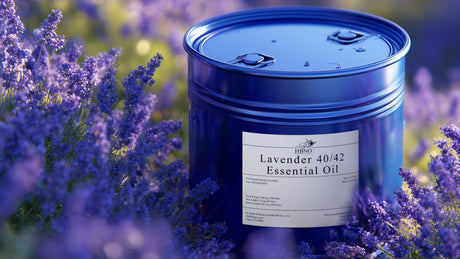Lavender essential oil is a timeless favorite in aromatherapy, personal care, and natural wellness. But not all lavender oils are created equal-especially when comparing Lavender 40/42 Oil to Pure Lavender Oil.
Understanding the distinction between Lavender 40/42 vs. Lavender Essential Oil is essential for formulators, retailers, and consumers alike. This guide explores their differences in composition, therapeutic value, uses, and pricing so you can confidently choose the right lavender oil for your needs.
Lavender 40/42 vs. Pure Lavender Oil: Chemical Differences
|
Feature |
Lavender 40/42 Oil |
Pure Lavender Essential Oil |
|
Linalool (%) |
Fixed at ~40% |
Varies naturally between 20% and 35% |
|
Linalyl Acetate (%) |
Fixed at ~42% |
Varies naturally between 30% and 55% |
|
Other Compounds |
May contain added or synthetic isolates |
Contains full spectrum of naturally occurring compounds |
|
Species Used |
Often a blend of multiple Lavandula species |
Only Lavandula angustifolia |
|
Standardization |
Highly standardized for fragrance consistency |
Naturally variable, batch to batch |
|
Price |
Typically lower |
Often higher, especially if organic or region-specific |
Therapeutic vs. Fragrance Use
One of the most important distinctions between Lavender 40/42 Oil and Pure Lavender Oil lies in their intended uses.
- Lavender 40/42 Oil is primarily used for its aroma. It's perfect for manufacturing products like air fresheners, lavender essential oil soaps, candles, and lotions, where scent matters more than therapeutic action. However, because the composition is adjusted-sometimes with added synthetics-it lacks the holistic complexity and purity desired in clinical or therapeutic settings.
- Lavender Essential Oil, on the other hand, is prized for its therapeutic benefits. Scientific studies have shown that Lavandula angustifolia essential oil may help reduce stress, promote sleep, alleviate headaches, and soothe skin irritations. These properties are largely attributed to its natural chemical complexity-something that standardized oils like 40/42 cannot fully replicate.
If your primary goal is aromatherapy, stress relief, or skin healing, opt for pure lavender oil. If your goal is consistent scent at scale, Lavender 40/42 Oil may be the better choice.

Safety and Quality Considerations
Both types of lavender oil are generally safe when used appropriately, but their differences are relevant when choosing a product for therapeutic vs. cosmetic use.
Lavender 40/42 is considered safe in personal care products and home fragrance applications, but its use in medicinal aromatherapy should be limited due to the potential inclusion of synthetic components. Always look for quality indicators on the label-such as "100% pure," "natural," or "no synthetics"-to understand what you're getting.
Pure Lavender Oil is generally safe for topical use when diluted, and for inhalation in diffusers or aromatherapy blends. However, as with all essential oils, patch testing is recommended to check for skin sensitivity. Pregnant women, children, and those with hormonal conditions should consult a healthcare provider before use, as lavender has known estrogenic activity in rare cases.
Pricing and Market Availability
Lavender 40/42 Oil is more cost-effective, making it accessible for everyday formulations and high-volume production. It's readily available from essential oil wholesalers and manufacturers that cater to cosmetic and cleaning product developers.
Pure Lavender Oil, especially when organic or sourced from high-altitude regions like Bulgaria or Provence, can be significantly more expensive. Prices can fluctuate based on weather, global demand, and crop yield, making it more of a specialty product.
If you're a brand formulating luxury skin care, therapeutic aromatherapy blends, or premium personal care items, pure lavender oil is a worthy investment. For companies focused on large-scale production where uniformity is key, Lavender 40/42 is a dependable and economical solution.
Which One Should You Use?
Here's a simple decision guide:
- ✅ Use Lavender 40/42 Oil if:
- You're making soap, candles, or body care products that need a consistent scent.
- Cost is a primary concern.
- You don't require the oil for clinical or therapeutic results.
- ✅ Use Pure Lavender Oil if:
- You want true aromatherapeutic benefits.
- You prioritize plant purity and complex natural composition.
- You're formulating for sensitive skin, emotional balance, or holistic health.
Conclusion
The difference between Lavender 40/42 and Pure Lavender Oil may seem subtle, but it carries significant implications for both consumers and formulators. Lavender 40/42 Oil is standardized for consistency and cost-efficiency in fragranced products, while Pure Lavender Essential Oil offers unmatched therapeutic value due to its natural chemical complexity.
At HBNO bulk, both types are available in bulk, making it easy to choose the right option based on your specific formulation needs. Whether you're crafting high-quality aromatherapy blends or cost-effective personal care products, lavender remains one of the most versatile and beloved essential oils in the world.



